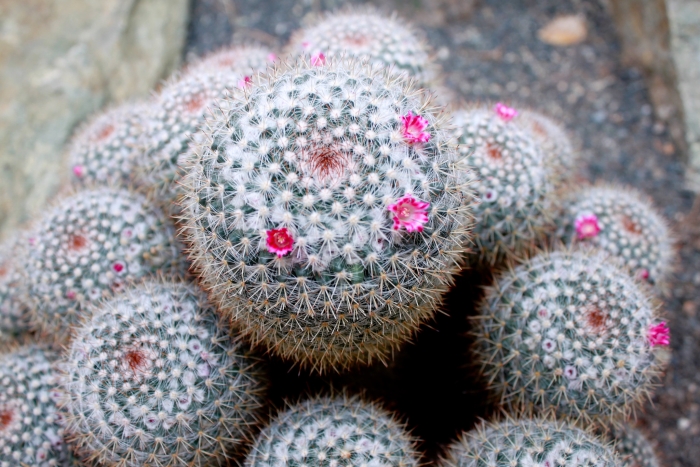Owl’s-Eye
(Mammillaria parkinsonii)
Owl’s-Eye (Mammillaria parkinsonii)
/
/

Brian Gratwicke
CC BY 2.0
Image By:
Brian Gratwicke
Recorded By:
Copyright:
CC BY 2.0
Copyright Notice:
Photo by: Brian Gratwicke | License Type: CC BY 2.0 | License URL: https://creativecommons.org/licenses/by-sa/2.0/ | Uploader: brian.gratwicke | Publisher: Flickr |


























Estimated Native Range
Summary
Mammillaria parkinsonii, commonly referred to as owl’s-eye pincushion or owl-eye cactus, is a perennial succulent native to semi-desert habitats in Queretaro, Mexico. This cactus is typically found in arid environments with sparse vegetation, often on rocky outcrops where it can avoid competition for resources. It is a slow-growing plant that reaches up to 12 inches (30 cm) in height and width, forming solitary or clustered globular stems covered in white wool and spines. The flowers are cream to pale yellow, blooming in a ring around the top of the stem in late winter to early spring, and are quite showy when in full bloom. The fruits are small, club-shaped, and red, adding to the plant’s ornamental value.
The owl’s-eye pincushion is valued for its unique spherical form and attractive spination, making it a popular choice for rock gardens, desert landscapes, and as a container plant. It is well-suited for xeriscaping due to its low water requirements. In cultivation, it thrives in full sun with very low to low water needs and requires a well-draining soil mix, typically a cactus or succulent potting mix. Overwatering is a common issue and can lead to root rot. It is also susceptible to pests such as mealybugs and scale insects. While it is endangered in the wild, it is often propagated in cultivation to preserve the species and reduce pressure on wild populations.CC BY-SA 4.0
The owl’s-eye pincushion is valued for its unique spherical form and attractive spination, making it a popular choice for rock gardens, desert landscapes, and as a container plant. It is well-suited for xeriscaping due to its low water requirements. In cultivation, it thrives in full sun with very low to low water needs and requires a well-draining soil mix, typically a cactus or succulent potting mix. Overwatering is a common issue and can lead to root rot. It is also susceptible to pests such as mealybugs and scale insects. While it is endangered in the wild, it is often propagated in cultivation to preserve the species and reduce pressure on wild populations.CC BY-SA 4.0
Plant Description
- Plant Type: Succulent
- Height: 4-6 feet
- Width: 4-5 feet
- Growth Rate: Slow
- Flower Color: Yellow, Pink
- Flowering Season: Summer
- Leaf Retention: Evergreen
Growth Requirements
- Sun: Full Sun
- Water: Very Low, Low
- Drainage: Fast
Common Uses
Drought Tolerant, Low Maintenance
Natural Habitat
Semi-desert habitats with rocky outcrops in Queretaro, Mexico
Other Names
Common Names: Owl-Eye Pincushion
Scientific Names: , Mammillaria parkinsonii, Mammillaria crucigera, Mammillaria pseudocrucigera, Mammillaria auriareolis, Mammillaria tiegeliana, Mammillaria rosensis, Cactus parkinsonii, Mammillaria dietrichiae, Mammillaria dietrichii
GBIF Accepted Name: Mammillaria parkinsonii C.Ehrenb.